These tables can help you estimate the thickness of pans you see listed online.
In my experience, the thickness of the copper in a pan is the single most important indicator of how it will perform in use — and also its value. The problem is that many online copper sellers don’t think to include copper thickness in the listing (or don’t know how to measure it accurately). For that reason, the weight of the piece is often its most important attribute: if you know the size and weight of a pan, you can assess how thick the copper is likely to be.
But in order to do that, you need some known pieces to which to compare it, so I’ve pulled together some representative measurements from pieces I’ve been able to handle. I trust these numbers with the caveat that they’re collected with amateur equipment — that is, a tape measure, dial caliper, and home digital scale.
There’s a lot of data so I’ve broken the tables out by type of pan.
How to use this information
Use these measurements to estimate the thickness of other pieces by comparing weight.
When you are considering buying a piece, compare its dimensions and weight to examples in the table below. For example, you see a 20cm saucepan listed online that weighs 2200g. Compare it to the two 20cm saucepans listed below: one example saucepan weighs 2000g and is 1.7mm thick; the other weighs almost 2900g and is 3.1mm thick. At 2200g, a 20cm saucepan you’re considering is just a little heavier than the 1.7mm piece, so it’s most likely about 2mm thick.
Keep in mind that there are natural variations in weight of pieces of the same measurement, from tens of grams for smaller pieces to 300g or more in the really big ones.
And always remember that weight — accurately measured! — never lies. Older pans are often thicker in the base than in the sidewalls: for example, an antique pan could measure 2.2mm at the rim and yet significantly outweigh a comparable 3mm piece. What this weight discrepancy usually means is that the antique pan has a base of thicker copper, which is an excellent quality in a cooking pan and quite desirable. Don’t overlook these hidden gems!
I hope this helps you know what to expect when you buy a piece of copper online. As always, let me know if you have questions about this!
Rondeaux
|
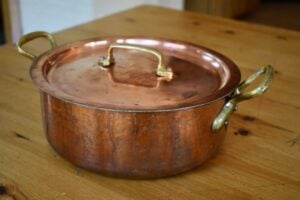 |
| (Falk) |
These are reference 2.5mm measurements as provided by Falk Culinaire for the dimensions and weights of its 2.5mm Classical series of steel-lined pieces. I assess that the weight difference between these steel-lined pieces and comparable tin-lined pieces will be negligible. |
| Metric measurements |
Thickness at rim (mm) |
Imperial measurements |
| Inside diameter (cm) |
Height (cm) |
Weight pan only (g) |
Weight with lid (g) |
Inside diameter (in) |
Height (in) |
Weight pan only (lbs) |
Weight with lid (lbs) |
| 16 (Falk) |
6 |
1190 |
|
2.5 |
6.3 |
2.4 |
2.6 |
|
| 18 |
6 |
1386 |
1642 |
2.5 |
7.1 |
2.4 |
3.06 |
3.62 |
| 20 (Falk) |
5.5 |
1700 |
|
2.5 |
7.9 |
2.2 |
3.75 |
|
| 22 |
8.5 |
2512 |
3056 |
3.0 |
8.7 |
3.3 |
5.54 |
6.74 |
| 24 (Falk) |
7 |
2360 |
|
2.5 |
9.4 |
2.8 |
5.2 |
|
| 26 |
8 |
2400 |
3250 |
2.1 |
10.2 |
3.1 |
5.29 |
7.17 |
| 28 |
9 |
2672 |
3578 |
2.0 |
11 |
3.5 |
5.89 |
7.89 |
| 28 (Falk) |
7.2 |
2940 |
|
2.5 |
11 |
2.8 |
6.48 |
|
| 28 |
9.5 |
4468 |
5390 |
3.0 |
11 |
3.7 |
9.85 |
11.88 |
| 30 |
11 |
5522 |
6962 |
3.0 |
11.8 |
4.3 |
12.17 |
15.35 |
| 31 |
12.5 |
6472 |
|
3.5 |
12.2 |
4.9 |
14.27 |
|
| 32 |
12.5 |
6026 |
|
3.1 |
12.6 |
4.9 |
13.29 |
|
| 32 |
12.5 |
7100 |
|
3.5 |
12.6 |
4.9 |
15.65 |
|
| Inside diameter (cm) |
Height (cm) |
Weight pan only (g) |
Weight with lid (g) |
Thickness (mm) |
Inside diameter (in) |
Height (in) |
Weight pan only (lbs) |
Weight with lid (lbs) |
| 34 |
9 |
7182 |
|
4.0 |
13.4 |
3.5 |
15.83 |
|
| 36 |
12.5 |
7958 |
9498 |
3.6 |
14.2 |
4.9 |
17.54 |
20.94 |
| 36 |
13.5 |
7712 |
9192 |
3.0 |
14.2 |
5.3 |
17 |
20.26 |
| 36 |
14 |
8880 |
|
3.0 |
14.2 |
5.5 |
19.58 |
|
| 38 |
11 |
8174 |
|
3.8 |
15 |
4.3 |
18.02 |
|
| 40 |
8.5 |
6562 |
|
3.0 |
15.7 |
3.3 |
14.47 |
|
| 40 |
11.5 |
10730 |
13128 |
4.0 |
15.7 |
4.5 |
23.66 |
28.94 |
| 50 |
17 |
12180 |
15700 |
2.5 |
19.7 |
6.7 |
26.85 |
34.61 |
| 51 |
16.5 |
16116 |
|
3.0 |
20.1 |
6.5 |
35.53 |
|
Saucepans
|
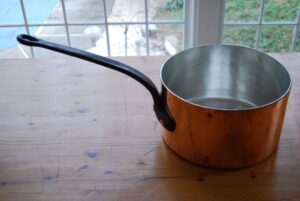 |
| (Falk) |
These are reference 2.5mm measurements as provided by Falk Culinaire for the dimensions and weights of its 2.5mm Classical series of steel-lined pieces. I assess that the weight difference between these steel-lined pieces and comparable tin-lined pieces will be negligible. |
| (HH) |
Helper handles. A second handle on a sauté pan, skillet, or saucepan will add weight. I’ve added a notation next to the weight entry because it will be be unusually high for a pan of that thickness. |
| Metric measurements |
Thickness at rim (mm) |
Imperial measurements |
| Inside diameter (cm) |
Height (cm) |
Weight (g) |
Inside diameter (in) |
Height (in) |
Weight (lbs) |
| 10 |
6.5 |
822 |
2.0 |
3.9 |
2.6 |
1.81 |
| 10 (Falk) |
5 |
560 |
2.5 |
3.9 |
2 |
1.2 |
| 12 |
7.5 |
612 |
1.3 |
4.7 |
3 |
1.35 |
| 12 |
7.5 |
1075 |
3.0 |
4.7 |
3 |
2.37 |
| 14 (Falk) |
7.4 |
1130 |
2.5 |
5.5 |
3 |
2.5 |
| 14 |
8.2 |
1460 |
2.9 |
5.5 |
3.2 |
3.22 |
| 16 |
8 |
1256 |
1.5 |
6.3 |
3.1 |
2.77 |
| 16 (Falk) |
7.8 |
1550 |
2.5 |
6.3 |
3 |
3.4 |
| 16 |
9.5 |
1905 |
3.0 |
6.3 |
3.7 |
4.2 |
| 18 (Falk) |
8.7 |
1900 |
2.5 |
7.1 |
3.4 |
4.2 |
| 18 |
10 |
2320 |
3.0 |
7.1 |
3.9 |
5.11 |
| 20 (Falk) |
10.2 |
2410 |
2.5 |
7.9 |
7.2 |
5.3 |
| 20 |
11 |
2895 |
3.1 |
7.9 |
4.3 |
6.38 |
| Inside diameter (cm) |
Height (cm) |
Weight (g) |
Thickness at rim (mm) |
Inside diameter (in) |
Height (in) |
Weight (lbs) |
| 22 |
12 |
3326 |
3.1 |
8.7 |
4.7 |
7.33 |
| 24 (Falk) |
11 |
3210 |
2.5 |
9.4 |
4.3 |
7 |
| 24 |
13 |
4370 |
3.4 |
9.4 |
5.1 |
9.63 |
| 26 |
15 |
4052 |
2.5 |
10.2 |
5.9 |
8.93 |
| 27 |
16 |
3706 |
1.8 |
10.6 |
6.3 |
8.17 |
| 28 |
15.5 |
3912 |
2.0 |
11 |
6.1 |
8.62 |
| 28 (Falk) |
12.5 |
4530 |
2.5 |
11 |
4.8 |
10 |
| 28 |
15 |
6014 |
3.8 |
11 |
5.9 |
13.26 |
| 30 |
17.4 |
8260 |
4.3 |
11.8 |
6.9 |
18.21 |
| 34 (HH) |
21 |
8982 |
2.8 |
13.4 |
8.3 |
19.80 |
| 34 (HH) |
30 |
11508 |
2.5 |
13.4 |
11.8 |
25.37 |
| 36 (HH) |
21.5 |
14350 |
3.6 |
14.2 |
8.5 |
31.64 |
Sauté pans
|
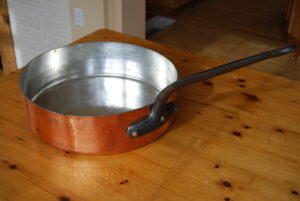 |
| (Falk) |
These are reference 2.5mm measurements as provided by Falk Culinaire for the dimensions and weights of its 2.5mm Classical series of steel-lined pieces. I assess that the weight difference between these steel-lined pieces and comparable tin-lined pieces will be negligible. |
| (HH) |
Helper handles. A second handle on a sauté pan, skillet, or saucepan will add weight. I’ve added a notation next to the weight entry because it will be be unusually high for a pan of that thickness. |
| Metric measurements |
Thickness at rim (mm) |
Imperial measurements |
| Inside diameter (cm) |
Height (cm) |
Weight (g) |
Inside diameter (in) |
Height (in) |
Weight (lbs) |
| 16 (Falk) |
6 |
1260 |
2.5 |
6.3 |
2.4 |
2.8 |
| 18 |
5.6 |
1665 |
3.0 |
7.1 |
2.2 |
3.67 |
| 19 |
5.5 |
1214 |
2.0 |
7.5 |
2.2 |
2.68 |
| 20 |
5.5 |
1310 |
2.0 |
7.9 |
2.2 |
2.89 |
| 20 (Falk) |
5.5 |
1760 |
2.5 |
7.9 |
2.2 |
3.9 |
| 20 |
6 |
2035 |
3.0 |
7.9 |
2.4 |
4.49 |
| 22 |
6.8 |
1906 |
2.0 |
8.7 |
2.7 |
4.2 |
| 22 |
7.5 |
2362 |
3.0 |
8.7 |
3 |
5.21 |
| 24 |
7.5 |
2516 |
2.0 |
9.4 |
3 |
5.55 |
| 24 (Falk) |
7 |
2640 |
2.5 |
9.4 |
2.8 |
5.8 |
| 24 |
7.5 |
2950 |
3.0 |
9.4 |
3 |
6.5 |
| Inside diameter (cm) |
Height (cm) |
Weight (g) |
Thickness at rim (mm) |
Inside diameter (in) |
Height (in) |
Weight (lbs) |
| 26 |
7.7 |
3282 |
2.5 |
10.2 |
3 |
7.24 |
| 26 |
8 |
3908 |
3.5 |
10.2 |
3.1 |
8.62 |
| 28 (Falk) (HH) |
7.2 |
3540 |
2.5 |
11 |
2.8 |
7.8 |
| 28 |
8 |
4604 |
3.5 |
11 |
3.1 |
10.15 |
| 30 |
8 |
3354 |
2.0 |
11.8 |
3.1 |
7.39 |
| 30 |
9 |
5370 |
3.4 |
11.8 |
3.5 |
11.84 |
| 30 |
9 |
5520 |
3.5 |
11.8 |
3.5 |
12.17 |
| 36 |
10.5 |
11712 |
4.5 |
14.2 |
4.1 |
25.82 |
| 36 (HH) |
8 |
7016 |
3.1 |
14.2 |
3.1 |
15.47 |
| 40 |
10.5 |
9170 |
3.7 |
15.7 |
4.1 |
20.22 |
| 41 (HH) |
12.5 |
9530 |
3.1 |
16.1 |
4.9 |
21.01 |
| 42 |
13 |
9816 |
3.0 |
16.5 |
5.1 |
21.64 |
| 44 |
10.5 |
15146 |
4.0 |
17.3 |
4.1 |
33.39 |
Skillets
|
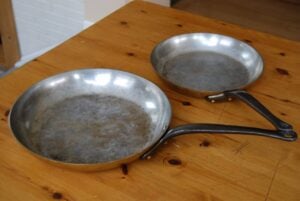 |
| (Falk) |
These are reference 2.5mm measurements as provided by Falk Culinaire for the dimensions and weights of its 2.5mm Classical series of steel-lined pieces. I assess that the weight difference between these steel-lined pieces and comparable tin-lined pieces will be negligible. |
| (HH) |
Helper handles. A second handle on a sauté pan, skillet, or saucepan will add weight. I’ve added an notation next to the weight entry because it will be be unusually high for a pan of that thickness. |
| Metric measurements |
Thickness at rim (mm) |
Imperial measurements |
| Inside diameter (cm) |
Height (cm) |
Weight (g) |
Inside diameter (in) |
Height (in) |
Weight (lbs) |
| 16 (Falk) |
4.2 |
1020 |
2.5 |
6.3 |
1.7 |
2.25 |
| 20 |
5 |
1428 |
2.5 |
7.9 |
2 |
3.15 |
| 20 (Falk) |
5 |
1500 |
2.5 |
7.9 |
2 |
3.3 |
| 24 (Falk) |
4.8 |
2050 |
2.5 |
7.9 |
1.9 |
4.5 |
| 26 |
5.5 |
2344 |
2.5 |
10.2 |
2.2 |
5.17 |
| 28 (Falk) |
4.8 |
2560 |
2.5 |
11 |
2 |
5.6 |
| 30 |
5.5 |
2586 |
2.5 |
11.8 |
2.2 |
6.28 |
| 31 (HH) |
5.5 |
3194 |
2.5 |
12.2 |
2.2 |
5.7 |
| 32 (Falk) |
5.6 |
3800 |
2.5 |
12.6 |
2.2 |
8.4 |
Soup pots
|
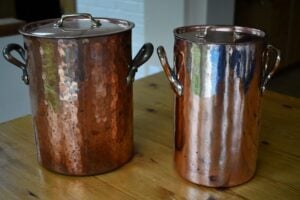 |
| Metric measurements |
Thickness at rim (mm) |
Imperial measurements |
| Inside diameter (cm) |
Height (cm) |
Weight no lid (g) |
Weight with lid (g) |
Inside diameter (in) |
Height (in) |
Weight no lid (lbs) |
Weight with lid (lbs) |
| 14 |
23 |
2622 |
2814 |
2.5 |
5.5 |
9.1 |
5.78 |
6.2 |
| 16 |
18.5 |
2166 |
2442 |
2.5 |
6.3 |
7.3 |
4.78 |
5.38 |
| 18 |
23.5 |
2254 |
2578 |
2.4 |
7.1 |
9.3 |
4.97 |
5.68 |
| 19.5 |
25.5 |
2554 |
2948 |
2 |
7.7 |
10 |
5.63 |
6.5 |
| 21.5 |
23 |
2950 |
3690 |
1.9 |
8.5 |
9.1 |
6.5 |
8.14 |
| 22 |
27 |
4542 |
4980 |
2.5 |
8.7 |
10.6 |
10.01 |
10.98 |
Stewpots
|
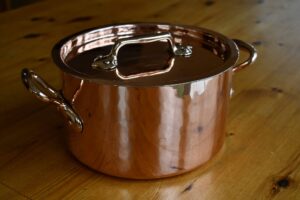 |
| (Falk) |
These are reference 2.5mm measurements as provided by Falk Culinaire for the dimensions and weights of its 2.5mm Classical series of steel-lined pieces. I used Falk’s “Casserole and pot-au-feu” category because the measurements most closely follow the proportions of what I call a stewpot, but note that the Falk examples may be a few cm shorter — and therefore lighter — than other 2.5mm stewpots of the same diameter. |
| Metric measurements |
Thickness at rim (mm) |
Imperial measurements |
| Inside diameter (cm) |
Height (cm) |
Pot weight only (g) |
Weight with lid (g) |
Inside diameter (in) |
Height (in) |
Pot weight only (lbs) |
Weight with lid (lbs) |
| 14 (Falk) |
7.4 |
1060 |
|
2.5 |
5.5 |
2.9 |
2.34 |
|
| 16 (Falk) |
7.8 |
1380 |
|
2.5 |
6.3 |
3.1 |
3.04 |
|
| 18 (Falk) |
8.7 |
1750 |
|
2.5 |
7.1 |
3.4 |
3.86 |
|
| 18 |
13.5 |
2408 |
2730 |
2.5 |
7.1 |
5.3 |
5.31 |
6.02 |
| 20 (Falk) |
10.2 |
2210 |
|
2.5 |
7.9 |
4 |
4.87 |
|
| 20 |
11.5 |
2042 |
2806 |
2.0 |
7.9 |
4.5 |
4.5 |
6.19 |
| 24 (Falk) |
11 |
2950 |
|
2.5 |
9.4 |
4.4 |
6.5 |
|
| 24 |
14.5 |
3782 |
4500 |
3.0 |
9.4 |
5.7 |
8.34 |
9.92 |
| 26 |
13.5 |
3880 |
4364 |
2.6 |
10.2 |
5.3 |
8.55 |
9.62 |
| 28 (Falk) |
12.5 |
3930 |
|
2.5 |
11 |
4.9 |
8.66 |
|
| 28 |
17 |
5324 |
6252 |
3.2 |
11 |
6.7 |
11.74 |
13.78 |
| 28 |
14.5 |
5672 |
|
3.7 |
11 |
5.7 |
12.5 |
|
| 28 |
15 |
6080 |
6996 |
4.0 |
11 |
5.9 |
13.4 |
15.42 |
| 30 |
16 |
7000 |
|
3.1 |
11.8 |
6.3 |
15.43 |
|
| 31 |
18 |
6406 |
|
3.0 |
12.2 |
7.1 |
14.12 |
|
| 32 |
17.5 |
6410 |
7586 |
3.1 |
12.6 |
6.9 |
14.13 |
16.72 |
| 34 |
18 |
8404 |
10694 |
3.0 |
13.4 |
7.1 |
18.53 |
23.58 |
| 40 |
22.5 |
9038 |
11326 |
3.0 |
15.7 |
8.9 |
19.93 |
24.97 |
| 50 |
26 |
18444 |
|
3.0 |
19.7 |
10.2 |
40.66 |
|
Stockpots
|
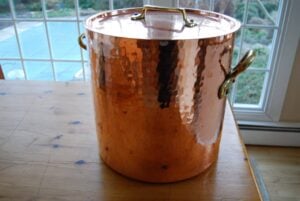 |
| Metric measurements |
Thickness at rim (mm) |
Imperial measurements |
| Inside diameter (cm) |
Height (cm) |
Pot weight only (g) |
Weight with lid (g) |
Inside diameter (in) |
Height (in) |
Pot weight only (lbs) |
Weight with lid (lbs) |
| 24 |
24 |
3260 |
3966 |
2.0 |
9.4 |
9.4 |
7.19 |
8.74 |
| 24 |
23.5 |
2992 |
3992 |
1.2 |
9.4 |
9.3 |
6.60 |
8.80 |
| 26 |
26 |
4630 |
5562 |
1.5 |
10.2 |
10.2 |
10.21 |
12.26 |
| 28 |
28 |
6480 |
6992 |
2.5 |
11.0 |
11.0 |
14.29 |
15.41 |
| 32 |
32 |
9940 |
11156 |
2.5 |
12.6 |
12.6 |
21.91 |
24.59 |
| 38 |
38.5 |
15304 |
|
2.5 |
15.0 |
15.2 |
33.74 |
Windsors
|
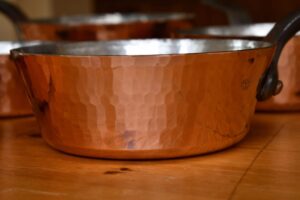 |
| Metric measurements |
Thickness at rim (mm) |
Imperial measurements |
| Inside diameter (cm) |
Height (cm) |
Weight (g) |
Inside diameter (in) |
Height (in) |
Weight (lbs) |
| 14 |
5.6 |
962 |
2.4 |
5.5 |
2.2 |
2.12 |
| 16 |
6 |
1210 |
2.2 |
6.3 |
2.4 |
2.67 |
| 17 |
6.5 |
1746 |
3 |
6.7 |
2.6 |
3.85 |
| 18 |
7 |
1736 |
3 |
7.1 |
2.8 |
3.83 |
| 20 |
7 |
2090 |
2.6 |
7.9 |
2.8 |
4.61 |
| 20 |
7.7 |
2100 |
2.8 |
7.9 |
3 |
4.63 |
| 20 |
7 |
2140 |
3.1 |
7.9 |
2.8 |
4.72 |
| 22 |
8 |
2544 |
3.2 |
8.7 |
3.1 |
5.61 |
| 24 |
8 |
3482 |
3.5 |
9.4 |
3.1 |
7.68 |
| 25.5 |
9.5 |
3237 |
3.4 |
10 |
3.7 |
7.14 |
| 27 |
9 |
5334 |
3.8 |
10.6 |
3.5 |
11.76 |
| 27.5 |
10 |
4384 |
3 |
10.8 |
3.9 |
9.67 |
Addenda
This page (like everything on this site) is a work in progress. As of March 2021 I’ve revised it to reorder the entries by ascending size, sort by weight, and to eliminate duplicative entries that could be confusing. I’ve chosen the items that I believe are best representative of their size and thickness. I’m always open to suggestions to make this information more comprehensible and useful, and if you see data here that makes no sense to you, it’s also possible I’ve made a data error! As always, please feel free to reach out with comments and questions.
Change log
October 2021: I have added measurements from Falk Culinaire’s Classical Range of steel-lined pieces with cast iron handles. These pieces are consistently 2.5mm thick and provide a good baseline for thickness estimates.
March 2022: I reordered the columns to put the “Thickness” in between the metric and imperial measurements. I hope this makes it easier for readers to scan across the rows.
Like this:
Like Loading...








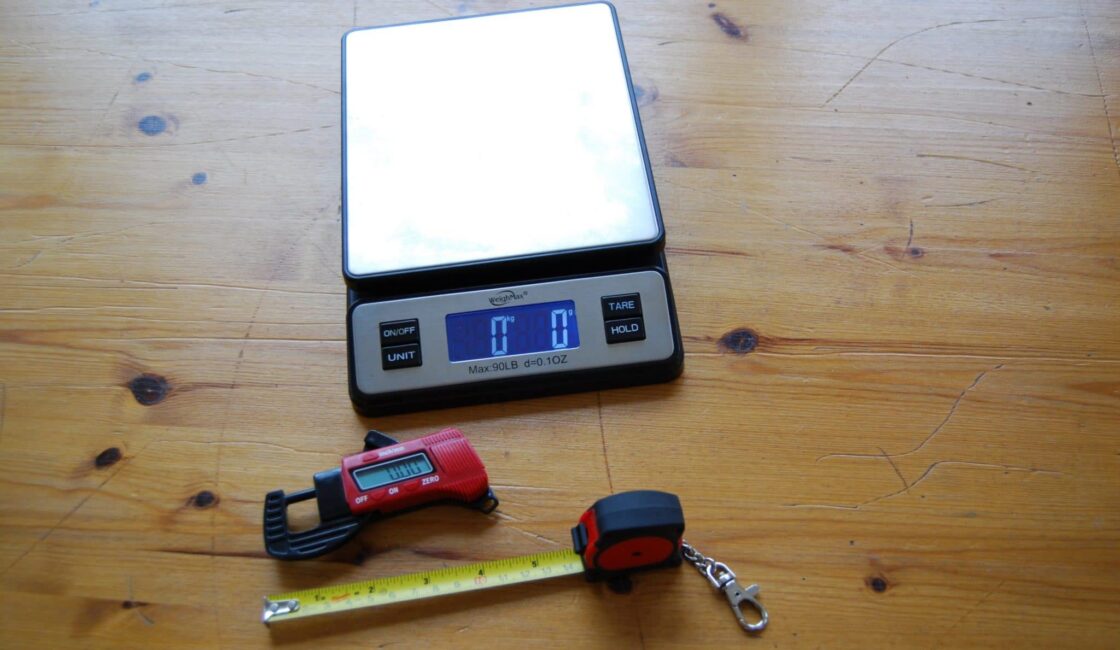
Hi, this is the first time I have tried access this since you added a lot more information and reformatted the page. Unfortunately I can’t see the all important right-hand column and don’t seem to be able to scroll or shrink to fit my screen as I could before. I am using a smart phone rather than laptop and am not good at this so the fault may well be mine.
Oh no!! I’m so sorry — I work on a laptop and I’m not always aware of how pages look on other devices. I’ve added code to the page so that the tables scroll horizontally rather than get cut off. Does that help?
That’s great thank you.
I am intrigued by the second 20cm saucepan which is almost 800g heavier than the one of similar dimensions listed below yet significantly thinner though not marked as “A” or “H” . Does it have an unusually long or chunky handle?
Roger, thanks for the excellent catch. That particular saucepan is an antique Dehillerin with a thick base and I mistakenly did not note it as (A). I’ve done so — thanks for noticing that!
So far, I thought I knew all pages of VFC. Until yesterday I came across “Reference: Measurements, weight, and thickness”. This page is said to be linked to the “Buyer’s Guide”, but I cannot find it there. No problem, I give this valuable orientation my own bookmark so that I can find it again quickly. By the way, I started to create a similar, albeit less extensive, list a few years ago in order to have my own references in my research. Since then, I have supplemented my list with every discovery.
Martin, I’m so glad it’s useful to you. I had two small reference pages earlier but discussions with a reader showed me that I had more useful data to share, so I consolidated them into one page and added much more data. This page is linked to the Buyer’s Guide under the “Buying copper online” section but perhaps it needs more prominence!
Thank you, now I have discovered the “hiding place”. I appreciate how much work there is behind such a table.
This is SO helpful! Recently I was able to estimate the 3mm thickness of a very blurry, inexpensive 2qt Ebay saucepan. Thank you!
To what extent does the material of the handle (iron versus brass) affect the weight? Thank you for sharing all of this invaluable information!
Hey KP! This reference (http://www.coyotesteel.com/assets/img/PDFs/weightspercubicfoot.pdf) says that brass is about 20% heavier than iron (brass weighs approximately 536 lbs/ft^3, cast iron weighs 442 lbs/ft^3, and wrought iron weighs 480 lbs/ft^3). But please keep in mind that these are all alloys and the precise weight of a given sample will depend on the composition, and on top of that, older antique pieces are more likely to have impurities in the metal. But this reference suggests that a brass handle will contribute more to the overall weight of a piece than an iron handle of the exact same dimensions.
Oh, very interesting, thank you! I was wondering if iron handles could make the reference weights above heavier, but it seems that wouldn’t be the case. Thanks again!